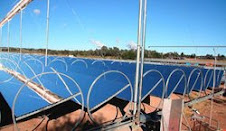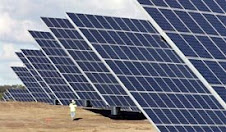But analysts warn sector is dangerous road, with much hype, stock correction, possible product oversupply

By Conor McCreery
Globeinvestor Magazine Online
July 28, 2008
Solar energy has long been heralded as the next big thing. This year UBS expects Germany, the world’s biggest market, to install 30 per cent more solar cells than it did a year ago. It also forecasts an 80-per-cent pop in the United States, and it says Spain’s capacity to capture solar energy will double. UBS expects Italy to install four times as much capacity as it did a year ago.
But the solar sector is still a dangerous road for investors. It’s a sector vulnerable to hype, and many stocks have fallen precipitously in the correction this year.
There is some worry that falling prices for raw materials could lead to oversupply (at least at current prices). Related to the price is the fact the industry is still dependent on major subsidies and feed-in tariffs or incentives for users to buy solar cells to make solar power competitive. So far, solar cells are still far less efficient at generating energy than conventional alternatives.
Industry watchers such as Tim Arcuri, an analyst with Citigroup, and Adam Krop, vice-president of equity research at Ardour Capital Investments LLC who also helps oversee the Market Vector Solar Energy exchange-traded fund, say grid-parity – the point at which solar is as efficient as conventional power – is still between four and six years away for most producers.
But here are five solar stocks you could possibly make money on now.

Fluor Corp.
$79.81 (U.S.): FLR/NYSE
Polysilicon is the material used to build most solar cells, and so polysilicon makers need factories – lots of them. One of the world’s largest engineering and construction companies, Irving, Tex.-based Fluor is poised to grab a huge chunk of that business.
"Fluor will be the "biggest beneficiary of the polysilicon opportunity" says UBS analyst Stephen Fisher. "It’s a move-the-needle type of opportunity."
He calculates that between $15-billion and $20-billion will be spent on polysilicon factories by 2012, and that Fluor’s track-record in building the first generation of these facilities should let them grab as much as $6-billion of that. He expects polysilicon construction pacts could boost Fluor’s 2009 share profit by between 9 and 11 per cent. His 12-month target price for Fluor stock is $215 (U.S.).
Suntech Power Holdings Co.
$33.29 (U.S.): STP/NYSE
Because a potential glut of supply of polysilicon could hammer margins, Mr. Krop has started to look to companies making cells and modules, and Chinese solar-scene giant Suntech is one of his favourites. "Suntech has a couple of key advantages – cheaper labour and scale," he says. It spends only about 5 to 7 per cent of revenue on labour, compared with an industry average of between 9 and 12 per cent, and is one of the world’s three largest producers of solar cells.
Citigroup analyst Jim Liang also favours Suntech in his latest report, noting it is likely to pre-sell all of 2009’s production by year-end 2008. And with some analysts worried that cheaper polysilicon could lead to an excess of solar cells by the end of the decade, Mr. Liang likes Suntech’s focus on profit margin preservation over expansion. Mr. Krop thinks that potential oversupply of polysilicon is good for Suntech for another reason. "Their one weakness has been their silicon costs have been higher than some of their peers" so falling spot prices should help the company mitigate some of its higher-cost silicon contracts. Mr. Krop has a 12-month stock-price target of $58, while Mr. Liang’s is $55.
First Solar Inc.
$262.46: FSLR/Nasdaq
Analysts sing First Solar’s praises. "People don’t fully appreciate how [it] is going to change the entire business model," Citigroup’s’ Mr. Arcuri says. The company’s thin-film modules could achieve "grid parity" as early as 2010 – two full years ahead of its nearest rival. Thin-film technology is a less bulkier product than traditional silicon cells. The technology uses cheaper cadmium telluride instead of polysilicon. While it is often less efficient than silicon cells, Mr. Krop says the cheaper thin-film is better for large commercial operations, where there is more roof space than on houses, to install the required amount of thin-film. He predicts the gap in price between thin-film and silicon cells will ultimately make thin-film the choice for business.
Mr. Arcuri believes Tempe, Ariz.-based First Solar is so far ahead of rivals as both a low-cost and high-volume producer that it may be almost impossible for them to catch up.
Mr. Arcuri’s 12-month price target for First Solar stock is $450, while Mr. Krop’s is $360.
Day4 Energy Inc.
$3.19: DFE/TSX
Trevor Johnson of Blackmont Capital calls Day4 Energy of Vancouver a solar module maker with a twist. "They put solar cells together in a cheaper way." Day4 installs cells into a flexible plastic sheet that boosts connectivity. Mr. Johnson says this proprietary technology makes the company’s modules between 7- and 10-per-cent more efficient than most competitors’ products. With Day4 expanding production capacity eight-fold, Mr. Johnson believes the company is closing in on the scale needed to push efficiency gains even further. Once the expansion is complete, Day4 plans to license its superior technology to other makers. Rating the stock a "speculative buy," with a 12-month $8 (Canadian) stock price target, Mr. Johnson says now is the time to get in. "They had an awful IPO, and in this industry momentum is everything. People lose confidence very quickly," he said. Blackmont has an investment banking relationship with Day4, and was one of the firms that took the stock public at $7.25 a share back in December, 2007.
Ascent Solar Technologies
$8.53 (U.S.): ASTI/Nasdaq
Ascent is another speculative name. It’s developing a technology called copper indium gallium selenide. (CIGS), which early tests have shown to be more efficient at converting solar energy into electricity than either polysilicon cells or cadmium telluride. Thus, it has potential to be an industry-changing technology.
Mr. Krop likes Littleton, Colo.-based Ascent because of how it plans to use CIGS. Ascent is working on putting the cells right into building materials - such as roofing membranes and aluminum siding, saving builders the cost of installing solar modules at a later date, and allowing modules to move beyond their traditional roof-top locale. While a competitor is looking to affix the CIGS to glass, Mr. Krop believes the plastic film lends itself to more diverse applications and therefore a much larger target market. He says that gives Ascent an "excellent opportunity" to partner with construction companies.
He expects Ascent to start shipping the new modules by the middle of 2010.
He rates the stock a "buy," with a 12-month stock price target of $15.
Conor McCreery is a producer at Business News Network
Full article at:
Solar Energy Stock Analysis in Globe Investor
Suggested Browsing:
Solar Power, Renewable Energy Investing Links
Wind Energy Stocks, Renewable Power Investing
Geothermal Company Links, Geothermal Power Stocks








No comments:
Post a Comment